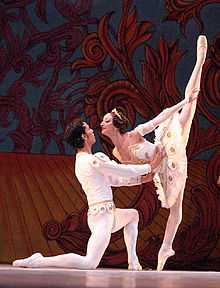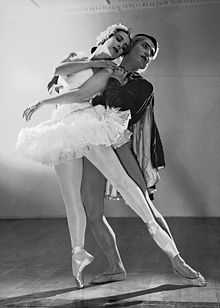Arabesque (ballet position)

In dance (particularly ballet), arabesque (aa-rah-besk; literally, "in Arabic fashion") is a body position in which a dancer stands on one leg (the supporting leg) with the other leg (the working leg) turned out and extended behind the body, with both legs held straight. In classical ballet, an arabesque can be executed with the supporting leg en pointe or demi pointe or with foot flat on the floor.
The working leg may touch the floor in tendu back (arabesque par terre) or be elevated. Common elevation angles of the raised leg are 45° (à demi hauteur) and 90° (à la hauteur). When the angle is much greater than 90° and the body trunk leans forward to counterbalance the working leg, the position is called arabesque penché (or penchée, a common misspelling of the French word[1]). The arms may be held in various positions.

Numbered variations in ballet
Vaganova
In the Vaganova method there are four basic arabesque positions. They are here described for a dancer facing Vaganova's fixed point 8 of the stage (that is, a dancer facing the front left corner of the stage). In class practice, the arms are always level with the shoulders (arabesque de classe), while in performance the arm in front may be raised above shoulder level (arabesque de scene). The elbows are always facing downwards.
In the first arabesque, the dancer stands in effacé position (for point 8, facing the front left corner, with the left foot in front) with the right leg raised in arabesque, the right arm extended to the side (to the audience) and the left arm extended front (towards the corner). The gaze follows the line of the arm extended en avant.
In the second arabesque the legs are like in the first arabesque, but the right arm is extended en avant while the left arm is extended aligned with the dancer's shoulder; the shoulders are in épaulement in line with the arms and the gaze is turned to the audience. The dancer's face focus must turn directly towards the audience/front/direction 1.
In the third arabesque the dancer stands in croisé position (for point 8, facing the front left corner, the right foot is in front) with the left leg raised in arabesque, the right arm extended to the side and a little behind the shoulder, and the left arm extended front. The gaze follows the line of the arm extended en avant.
In the fourth arabesque position the dancer stands in croisé as for the third arabesque, but the right arm is extended front and the left arm is extended as far back as possible in line with the right arm. The shoulders are in strong épaulement and the dancer's focus is turned to the audience.
Method: in arabesque tendue or dégagé, the leg comes from the hip and does not affect the aplomb of the dancer, as the back remains straight. Most dancers do not have absolute rotation through the supporting leg, therefore the working hip may open,* (without lifting into the lower ribs), while the supporting hip lifts forward over the supporting foot, maintaining a spiral rotation through the legs, with the whole of the supporting foot anchored to the floor. (Supporting arch if flat, metatarsus if en demi pointe, first or second toe/phalange if en pointe.)
When the leg is moved or held above 45 degrees or so, the dancer curves the spine both laterally and vertically. The method is to: 1) anchor the shoulders and scapula downward without tension, keeping both shoulder's "square" (aligned parallel with the direction the dancer is facing). The sternum must lift without hyperextending the ribcage. 2) keep the supporting hip forward, as mentioned above. The spine curves to the anterior, keeping the head lifted to focus straight forward to diagonally up. The current standard height and degree for the Vaganova arabesque is 110 degrees. Vaganova method maintains that, in classical ballet, both the supporting and the working legs must be fully turned out through the legs, (not only from the hips), even in full arabesque. If the choreography requires the dancer to open her/his arms, the performer should rotate the shoulders around the spine, so the shoulders do not affect the position of the back and spine and/or shoulders.
- Note that allowing for the dancer to open the hips is distinctly different than some older methods, that require the hips to remain down. Restraining the hips restricts range of motion, restricting the full curvature of the spine, (not allowing the spine to rotate laterally, thus increases compaction of vertebrae); nor for most dancers, to exhibit an outwardly rotated leg. Opening the hip allows dancers with lesser mobile bodies to safely achieve greater range of motion in arabesque.
Royal Academy of Dance
In the RAD system, there are three main arabesques. Here they are described facing point 6 (front right):
First arabesque is taken standing en ouvert on the right leg with the left leg extended. The right arm is extended forwards at eye height, parallel with the right shoulder. The left arm is at the side, slightly behind and below the left shoulder.
Second arabesque has a more 'square' feel to it. The dancer stands on their left leg, with their right leg extended. The right arm is extended forwards at shoulder height, and the left arm is extended directly sideways from the shoulder. This can also be taken en ouvert, standing on the right leg and extending the leftarm forwards.
Third arabesque is taken en ouvert. The dancer stands on their right leg, with their left leg extended behind. The right arm is extended forwards at eye height, and the left arm is extended parallel to it at shoulder height.
Further reading
- Vaganova, A. Basic principles of classical ballet. Dover Publications, Inc. ISBN 0-486-22036-2.
- Kostrovitskaya, Vera (1981). 100 Lessons in Classical Ballet. Oleg Briansky (translator). Limelight Editions, New York. ISBN 0-87910-068-0.
- Messerer, Asaf (1975) [1972]. Classes in Classical Ballet. Oleg Briansky (translator). Doubleday and Co Inc., New York. ISBN 0-385-04599-9.
- Grant, G (1982). Technical manual and dictionary of classical ballet. Dover Publications. ISBN 0-486-21843-0.
References
- ↑ American Ballet Theatre. "Penché, penchée". Retrieved 10 April 2014.
External links
-
 Media related to Arabesque (dance) at Wikimedia Commons
Media related to Arabesque (dance) at Wikimedia Commons
| ||||||||||||||||||||||||||||||||||||
